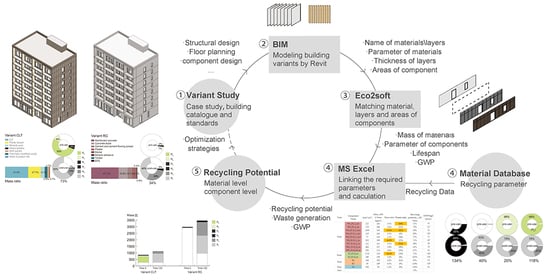Recycling Potential Comparison of Mass Timber Constructions and Concrete Buildings: A Case Study in China
Abstract
:1. Introduction
2. Literature Review
2.1. Mass Timbers and Mass Timber Construction
2.2. Recycling Potential of Materials, Components, and Buildings
3. Research Methodology
3.1. Level-Based Assessment Scheme
3.2. Variant Study
3.3. Workflow, Data, and Tools
4. Results
4.1. Comparison of Material-Level Recycling Potential
4.2. Comparison of Component-Level Recycling Potential
4.3. The Detachiability of Components
4.4. Comparison of Building-Level Recycling Potential
4.5. Sensitivity Analysis of Potential Parameters Affecting GWP and RP
5. Discussion
6. Conclusions
Supplementary Materials
Author Contributions
Funding
Institutional Review Board Statement
Informed Consent Statement
Data Availability Statement
Conflicts of Interest
References
- Hertwich, E.G. Increased carbon footprint of materials production driven by rise in investments. Nat. Geosci. 2021, 14, 151–155. [Google Scholar] [CrossRef]
- Lei, J.; Huang, B.; Huang, Y. Life cycle thinking for sustainable development in the building industry. In Life Cycle Sustainability Assessment for Decision-Making; Elsevier: Amsterdam, The Netherlands, 2020; pp. 125–138. [Google Scholar]
- Crowther, P. Design for disassembly—Themes and principles. Environ. Des. Guide 2005, 2, 1–7. [Google Scholar]
- Thormark, C. Recycling Potential and Design for Disassembly in Buildings; Lund University: Lund, Sweden, 2001. [Google Scholar]
- McDonough, W.; Braungart, M. Cradle to Cradle: Remaking the Way We Make Things; North Point Press: New York, NY, USA, 2002. [Google Scholar]
- Brunner, P.H. Urban mining a contribution to reindustrializing the city. J. Ind. Ecol. 2011, 15, 339–341. [Google Scholar] [CrossRef]
- Reversible Building Design. Available online: https://www.bamb2020.eu/ (accessed on 3 March 2022).
- Thormark, C. A low energy building in a life cycle—Its embodied energy, energy need for operation and recycling potential. Build. Environ. 2002, 37, 429–435. [Google Scholar] [CrossRef]
- Thormark, C. The effect of material choice on the total energy need and recycling potential of a building. Build. Environ. 2006, 41, 1019–1026. [Google Scholar] [CrossRef]
- Blengini, G.A. Life cycle of buildings, demolition and recycling potential: A case study in Turin, Italy. Build. Environ. 2009, 44, 319–330. [Google Scholar] [CrossRef]
- Abd Rashid, A.F.; Yusoff, S. A review of life cycle assessment method for building industry. Renew. Sustain. Energy Rev. 2015, 45, 244–248. [Google Scholar] [CrossRef] [Green Version]
- Harte, A.M. Mass timber—The emergence of a modern construction material. J. Struct. Integr. Maint. 2017, 2, 121–132. [Google Scholar] [CrossRef]
- Jayalath, A.; Navaratnam, S.; Ngo, T.; Mendis, P.; Hewson, N.; Aye, L. Life cycle performance of Cross Laminated Timber mid-rise residential buildings in Australia. Energy Build. 2020, 223, 110091. [Google Scholar] [CrossRef]
- Honic, M.; Kovacic, I.; Rechberger, H. Improving the recycling potential of buildings through Material Passports (MP): An Austrian case study. J. Clean. Prod. 2019, 217, 787–797. [Google Scholar] [CrossRef]
- Parisi, M.A.; Piazza, M. Seismic strengthening and seismic improvement of timber structures. Constr. Build. Mater. 2015, 97, 55–66. [Google Scholar] [CrossRef] [Green Version]
- Létourneau-Gagnon, M.; Dagenais, C.; Blanchet, P. Fire performance of self-tapping screws in tall mass-timber buildings. Appl. Sci. 2021, 11, 3579. [Google Scholar] [CrossRef]
- Augustin, S.; Fell, D. Wood as a Restorative Material in Healthcare Environments; FPInnovations: Vancouver, BC, Canada, 2015. [Google Scholar]
- Kaufmann, H.; Krötsch, S.; Winter, S. Manual of multistorey timber construction. In Manual of Multistorey Timber Construction; Detail Business Information GmbH: Munich, Germany, 2018. [Google Scholar]
- Brandner, R.; Flatscher, G.; Ringhofer, A.; Schickhofer, G.; Thiel, A. Cross laminated timber (CLT): Overview and development. Eur. J. Wood Wood Prod. 2016, 74, 331–351. [Google Scholar] [CrossRef]
- Liang, S.; Gu, H.; Bergman, R. Environmental life-cycle assessment and life-cycle cost analysis of a high-rise mass timber building: A case study in Pacific Northwestern United States. Sustainability 2021, 13, 7831. [Google Scholar] [CrossRef]
- Barber, D. Fire safety of mass timber buildings with CLT in USA. Wood Fiber Sci. 2018, 50, 83–95. [Google Scholar] [CrossRef]
- Sun, X.; He, M.; Li, Z.; Lam, F. Seismic performance assessment of conventional CLT shear wall structures and post-tensioned CLT shear wall structures. Eng. Struct. 2019, 196, 109285. [Google Scholar] [CrossRef]
- Adekunle, T.O. Thermal performance and apparent temperature in school buildings: A case of cross-laminated timber (CLT) school development. J. Build. Eng. 2021, 33, 101731. [Google Scholar] [CrossRef]
- Wang, J.; Stirling, R.; Morris, P.I.; Taylor, A.; Lloyd, J.; Kirker, G.; Lebow, S.; Mankowski, M.; Barnes, H.M.; Morrell, J.J. Durability of mass timber structures: A review of the biological risks. Wood Fiber Sci. 2018, 50, 110–127. [Google Scholar] [CrossRef] [Green Version]
- Atta, I.; Bakhoum, E.S.; Marzouk, M.M. Digitizing material passport for sustainable construction projects using BIM. J. Build. Eng. 2021, 43, 103233. [Google Scholar] [CrossRef]
- Heisel, F.; Rau-Oberhuber, S. Calculation and evaluation of circularity indicators for the built environment using the case studies of UMAR and Madaster. J. Clean. Prod. 2020, 243, 118482. [Google Scholar] [CrossRef]
- Madaster Platform. Madaster. Available online: https://docs.madaster.com/nl/nl/ (accessed on 20 December 2021).
- Annette, H.; Johanna-Katharina, S. The Recycling Potential of Building Materials. In Manual of Recycling: Buildings as Sources of Materials; Detail Business Information GmbH: Munich, Germany, 2019. [Google Scholar]
- Cai, G.; Waldmann, D. A material and component bank to facilitate material recycling and component reuse for a sustainable construction: Concept and preliminary study. Clean Technol. Environ. Policy 2019, 21, 2015–2032. [Google Scholar] [CrossRef]
- Akanbi, L.A.; Oyedele, L.O.; Omoteso, K.; Bilal, M.; Akinade, O.O.; Ajayi, A.O.; Owolabi, H.A. Disassembly and decon-struction analytics system (D-DAS) for construction in a circular economy. J. Clean. Prod. 2019, 223, 386–396. [Google Scholar] [CrossRef]
- Schwede, D.; Störl, E. Methode zur Analyse der Rezyklierbarkeit von Baukonstruktionen. Bautechnik 2017, 94, 1–9. [Google Scholar] [CrossRef]
- Nautiyal, H.; Shree, V.; Khurana, S.; Kumar, N. Recycling potential of building materials: A review. In Environmental Footprints and Eco-Design of Products and Processes; Springer: Berlin/Heidelberg, Germany, 2015; pp. 31–50. [Google Scholar]
- Condeixa, K.; Haddad, A.; Boer, D. Material flow analysis of the residential building stock at the city of Rio de Janeiro. J. Clean. Prod. 2017, 149, 1249–1267. [Google Scholar] [CrossRef]
- De Wolf, C.; Hoxha, E.; Fivet, C. Comparison of environmental assessment methods when reusing building components: A case study. Sustain. Cities Soc. 2020, 61, 102322. [Google Scholar] [CrossRef]
- Dauletbek, A.; Zhou, P. BIM-based LCA as a comprehensive method for the refurbishment of existing dwellings considering environmental compatibility, energy efficiency, and profitability: A case study in China. J. Build. Eng. 2022, 46, 103852. [Google Scholar] [CrossRef]
- Cheng, B.; Lu, K.; Li, J.; Chen, H.; Luo, X.; Shafique, M. Comprehensive assessment of embodied environmental impacts of buildings using normalized environmental impact factors. J. Clean. Prod. 2022, 334, 130083. [Google Scholar] [CrossRef]
- Eco2soft. Baubook. Available online: https://www.baubook.info/eco2soft/ (accessed on 20 September 2021).
- Schwede, D. Application of Recycling Graphs for the Optimisation of the Recyclability in Building Information Modelling. IOP Conf. Ser. Earth Environ. Sci. 2019, 323, 012044. [Google Scholar] [CrossRef]
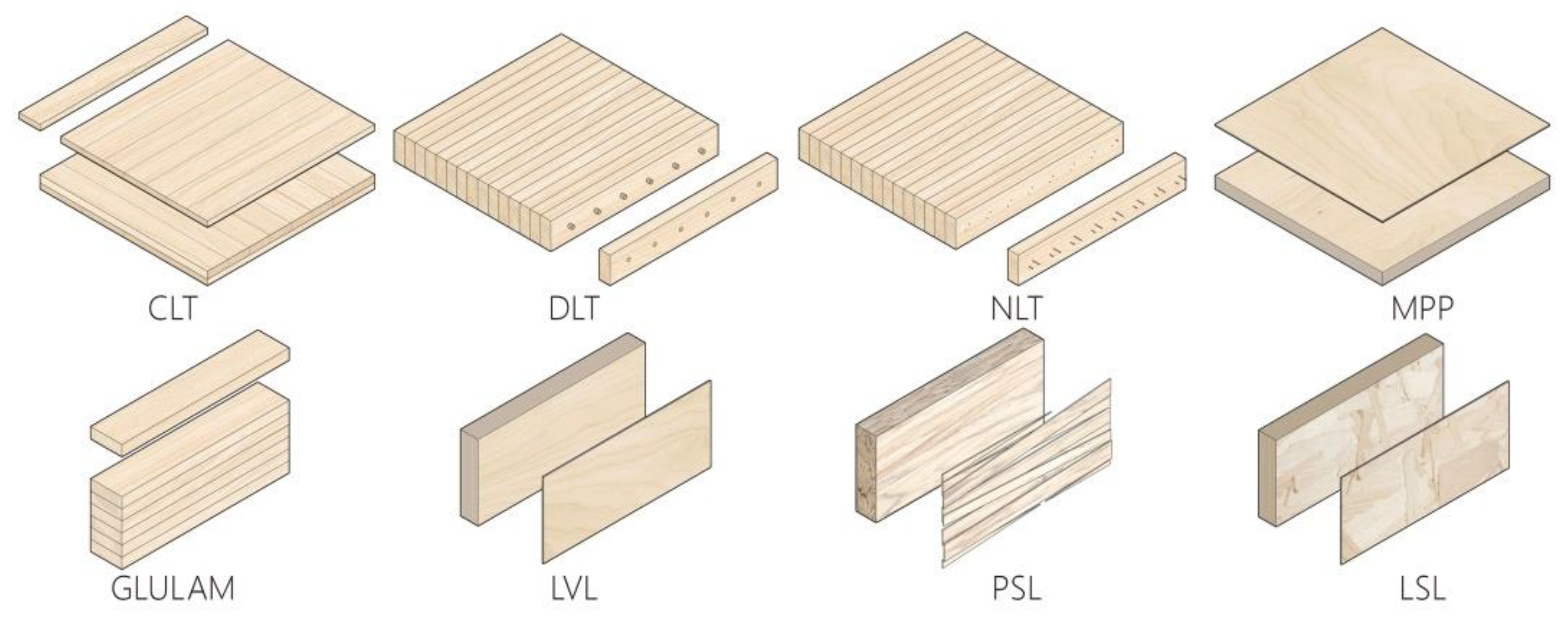
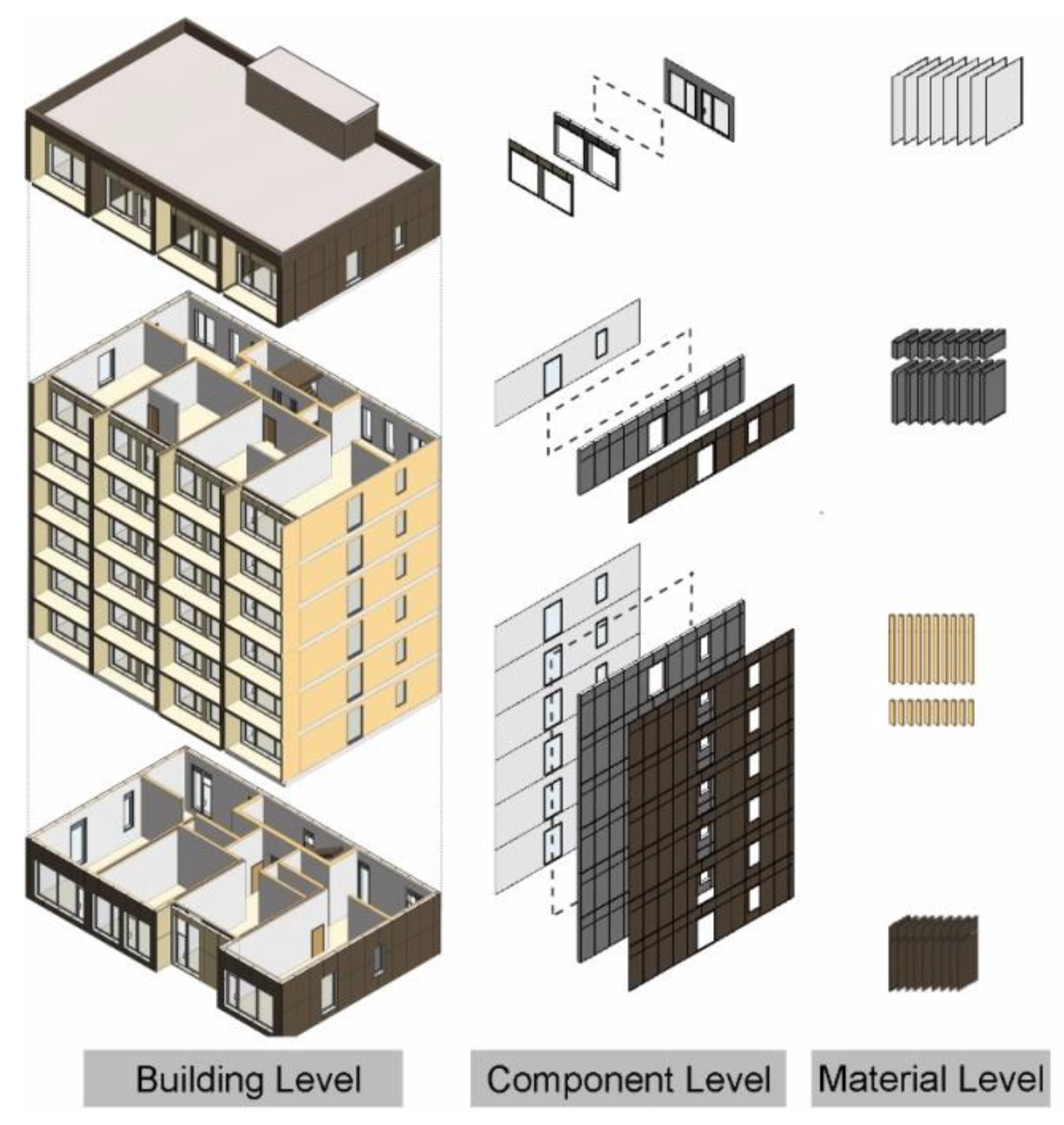


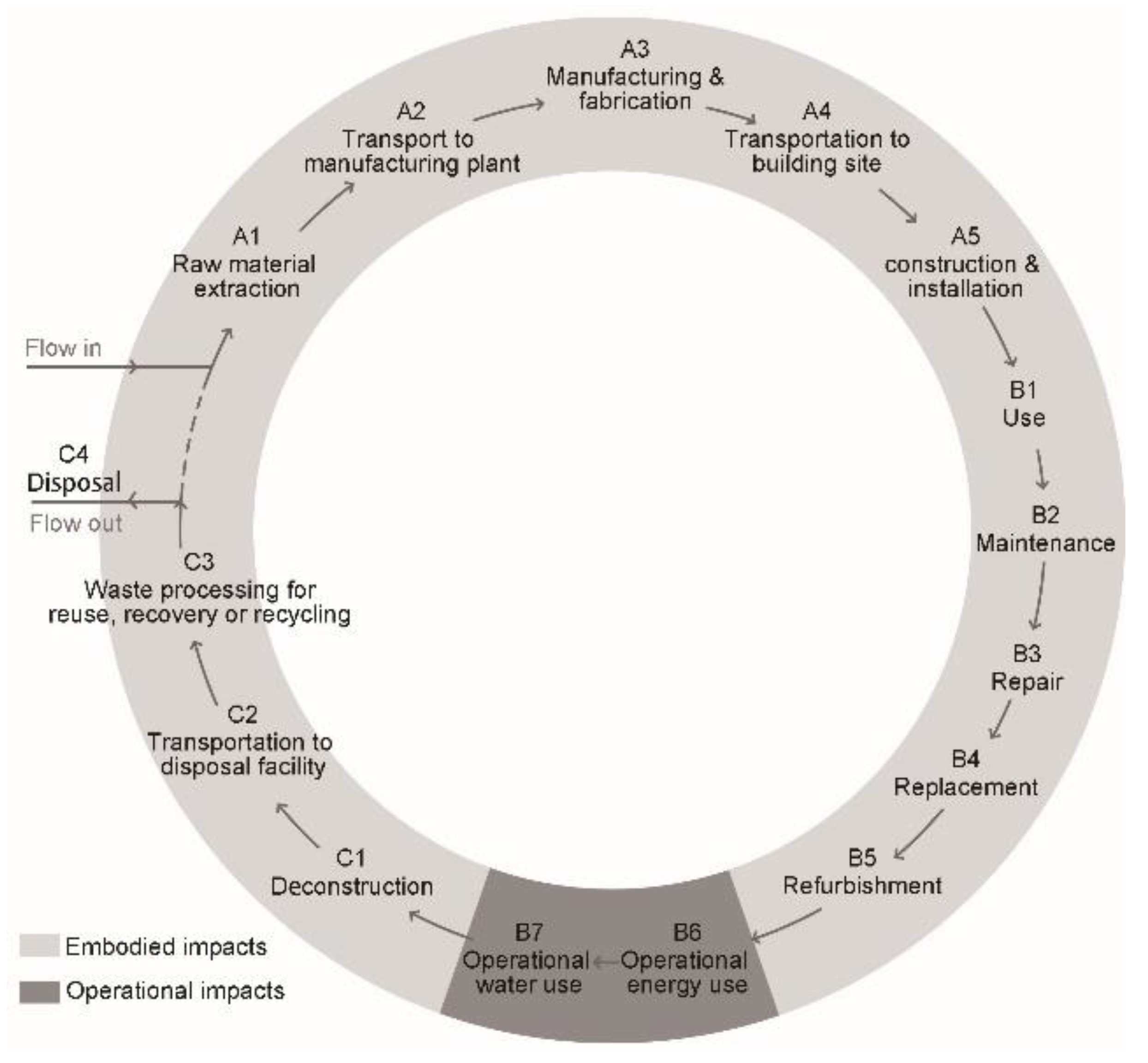
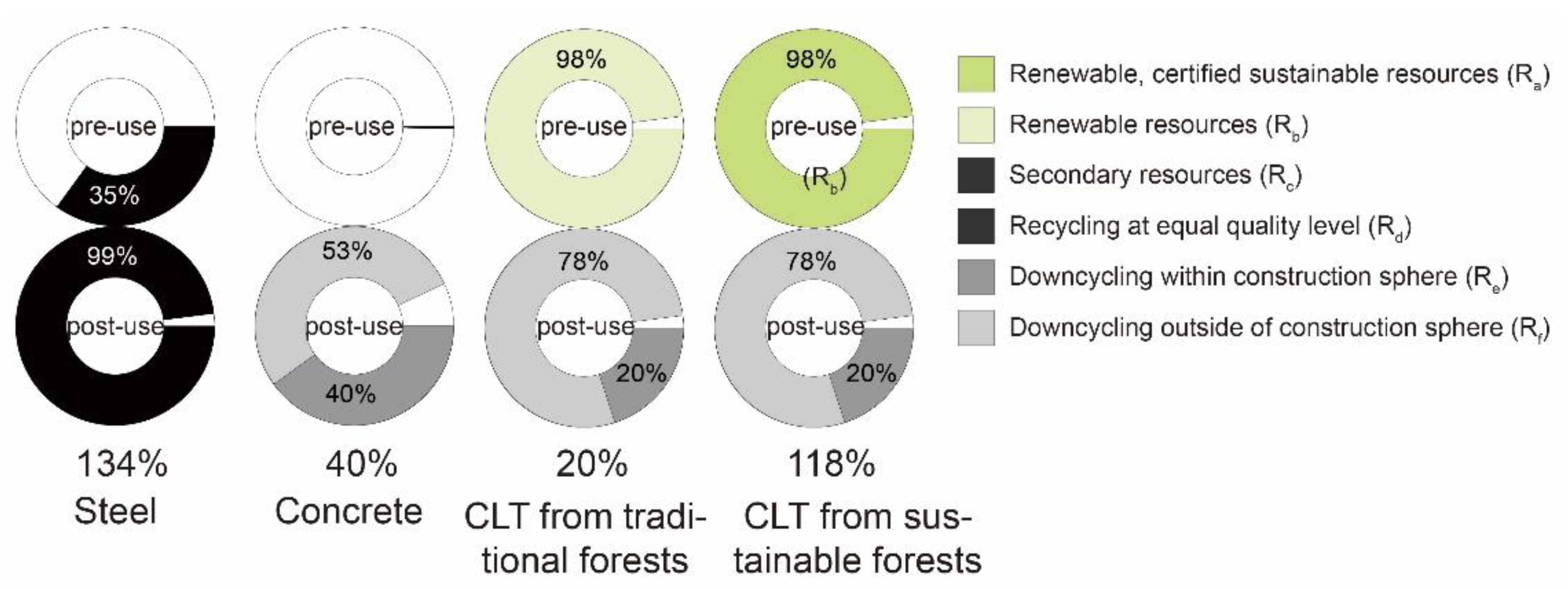



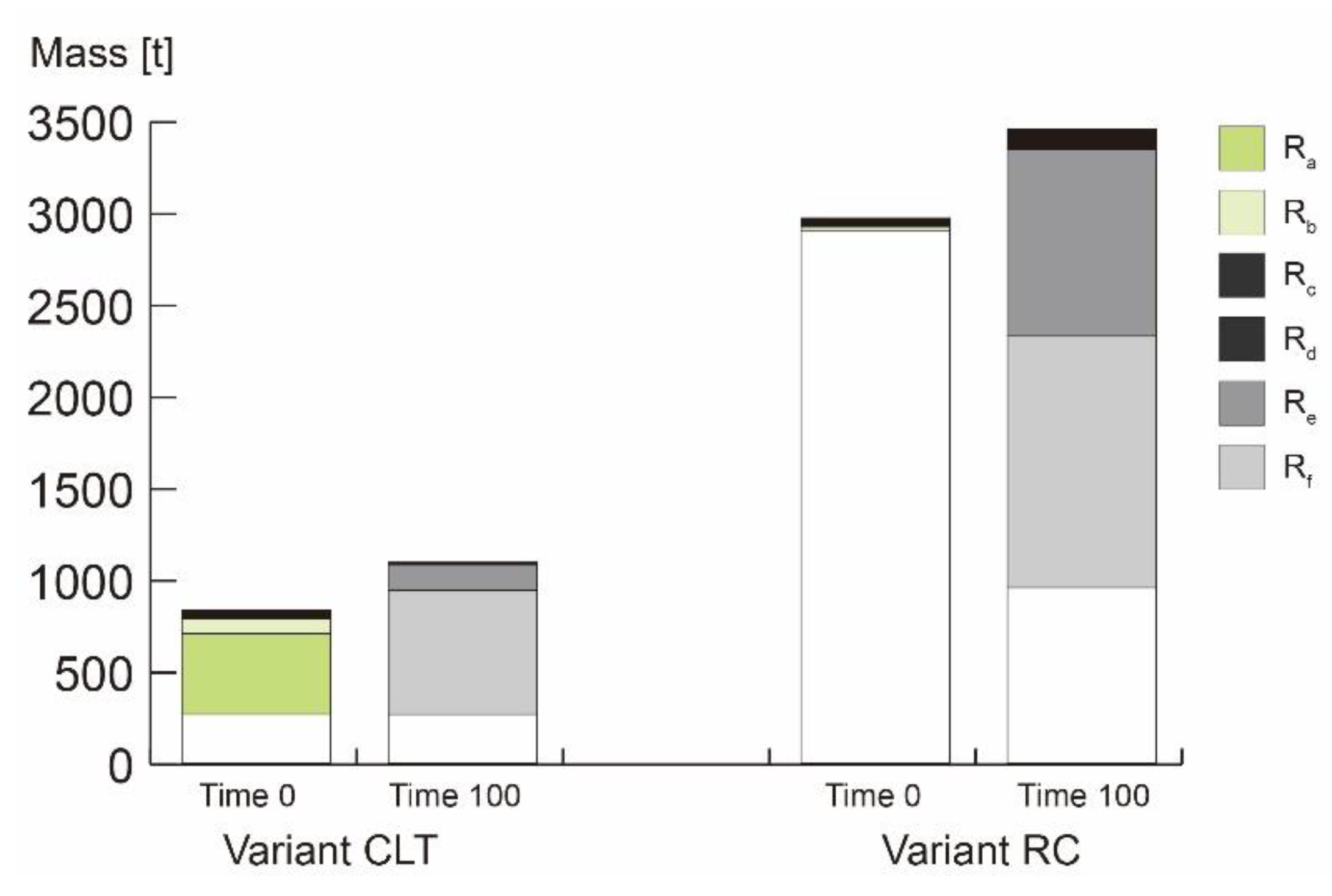
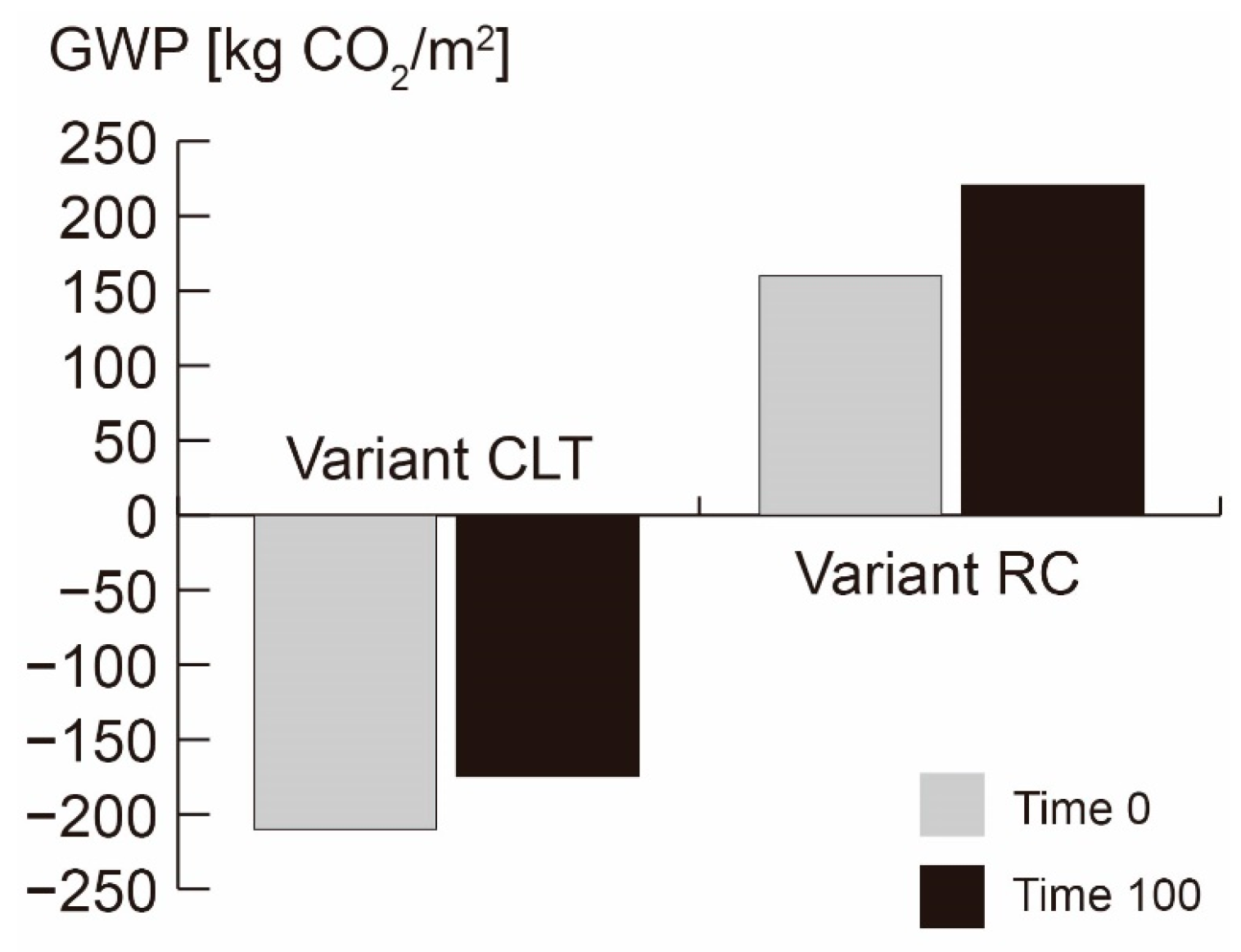
| Component | Material Composition | Density (kg/m2) | Mass Ratio | Ra * | Rb * | Rc * | Rd * | Re * | Rf * | Waste | Recycling Potential |
|---|---|---|---|---|---|---|---|---|---|---|---|
| CLT Exterior Wall Components | 15 mm plasterboard | 12.2 | 10.4% | - | - | 2% | 5% | - | 40% | 55% | 7% |
| 135 mm CLT | 64.1 | 54.7% | 98% | - | - | - | 20% | 80% | 0% | 118% | |
| 220 mm mineral wool | 19.6 | 16.8% | - | - | 60% | - | - | - | 100% | 60% | |
| 50/220 mm wood battens | 4.2 | 3.6% | - | 100% | - | - | 20% | 80% | 0% | 20% | |
| 15 mm MDF panels | 6.0 | 5.1% | 46% | 50% | - | - | 20% | 80% | 0% | 66% | |
| 50/30 mm wood battens | 0.6 | 0.5% | - | 100% | - | - | 20% | 80% | 0% | 20% | |
| 20 mm thermally modified wood | 10.5 | 9.0% | - | 100% | - | - | 20% | 80% | 0% | 20% | |
| Sum | 117.2 | 56% | 16% | 10% | 1% | 15% | 62% | 22% | 81.0% |
| Component | Material Composition | Density (kg/m2) | Mass Ratio | Ra * | Rb * | Rc * | Rd * | Re * | Rf * | Waste Ratio | Recycling Potential |
|---|---|---|---|---|---|---|---|---|---|---|---|
| Concrete Exterior Wall Components | 15 mm mortar | 22.5 | 6.9% | - | - | 2% | - | - | 100% | 2% | |
| 200 mm hollow concrete blocks | 280.0 | 85.4% | - | - | - | - | 40% | 53% | 7% | 40% | |
| 5 mm mineral adhesive | 9.0 | 2.7% | - | - | 2% | - | - | 100% | 2% | ||
| 220 mm EPS-F | 3.7 | 1.1% | - | - | - | - | 27% | 66% | 7% | 27% | |
| 7 mm plaster | 12.6 | 3.8% | - | - | 2% | - | - | 100% | 2% | ||
| Sum | 327.8 | - | - | 0% | - | 34% | 46% | 20% | 35% |
| Material Used in Variant CLT | Lifespan (Years) | Substance Consumption *_ 100th Year (kg) | Mass Ratio | Waste_ 100 Years (kg) | Recycling Potential | Recycling Potential Contribution | GWP * (kgCO2) |
|---|---|---|---|---|---|---|---|
| CLT | 100 | 565,731 | 51.5% | 0 | 118% | 60.8% | −622,304 |
| Plasterboard | 50 | 304,074 | 27.7% | 167,241 | 7% | 1.9% | 47,740 |
| Mineral wool | 50 | 99,996 | 9.1% | 99,996 | 60% | 5.5% | 100,996 |
| Thermally modified wood | 50 | 64,622 | 5.9% | 0 | 20% | 1.2% | −106,626 |
| MDF panels | 50 | 51,138 | 4.7% | 0 | 66% | 3.1% | −53,184 |
| Wood battens | 100 | 7369 | 0.7% | 0 | 20% | 0.1% | −7737 |
| Wool insulation felt | 50 | 4760 | 0.4% | 0 | 0% | 0.0% | 2556 |
| Sum | - | 1,097,690 | 100% | 267,237 | 73% | - | - |
| Material Used in Variant RC | Lifespan (Years) | Substance Consumption *_ 100th Year (kg) | Mass Ratio | Waste _ 100th Year (kg) | Recycling Potential | Recycling Potential Contribution | GWP * (kgCO2) |
|---|---|---|---|---|---|---|---|
| Reinforced concrete | 100.0 | 1,973,996 | 57.1% | 131,329 | 45% | 25.9% | 305,969 |
| Concrete block | 100.0 | 653,240 | 18.9% | 45,727 | 40% | 7.6% | 62,123 |
| Cement and cement flowing screed | 50.0 | 348,120 | 10.1% | 348,120 | 2% | 0.2% | 41,774 |
| Plaster | 35.0 | 283,236 | 8.2% | 283,236 | 2% | 0.2% | 50,416 |
| Mortar | 35.0 | 117,597 | 3.4% | 117,597 | 2% | 0.1% | 76,556 |
| Mineral adhesive | 50.0 | 30,042 | 0.9% | 30,042 | 2% | 0.0% | 10,244 |
| Timber | 50.0 | 22,332 | 0.6% | 0 | 20% | 0.1% | 3685 |
| EPS | 35.0 | 29,925 | 0.9% | 2095 | 27% | 0.2% | 124,787 |
| Sum | - | 3,458,488 | 100% | 958,145 | 34% | - | - |
| Type | Component Name | Area * (m2) | Mass_100th Years (kg/m2) | Mass Ratio | Waste Ratio | Recycling Potential__100 Years | GWP * (kgCO2/m2) |
|---|---|---|---|---|---|---|---|
| Wall | W1_F1_L_ex | 212 | 166 | 3.2% | 30% | 72% | −57 |
| W2_F1_L_in | 178 | 208 | 3.4% | 21% | 73% | −117 | |
| W3_F2-8_L_ex1 | 1035 | 165 | 15.6% | 32% | 69% | −51 | |
| W4_F2-8_L_ex2 | 219 | 160 | 3.2% | 0% | 90% | −152 | |
| W5_F2-8_L_ex3 | 77 | 163 | 1.1% | 24% | 72% | −71 | |
| W6_F2-8_L_in | 925 | 199 | 16.8% | 22% | 71% | −107 | |
| W7_F1-8_L_in | 211 | 161 | 3.1% | 51% | 58% | −30 | |
| W8_ F1-8_N_in | 406 | 157 | 5.8% | 28% | 61% | −70 | |
| W9_ F1-8_N_in | 303 | 176 | 4.9% | 25% | 67% | −91 | |
| Floor | F1_F1-8_in | 1715 | 219 | 34.3% | 23% | 72% | −104 |
| F2_F1-8_ex | 190 | 139 | 2.4% | 0% | 102% | −134 | |
| Roof | R1 | 268 | 185 | 4.5% | 31% | 83% | −53 |
| R2 | 30 | 109 | 0.3% | 0% | 118% | −118 | |
| Stair | S1 | 538 | 28 | 1.4% | 0% | 118% | −31 |
| Sum | 73% |
| Type | Component Name | Area * (m2) | Mass_100 Years (kg/m2) | Mass Ratio | Waste Ratio | Recycling Potential__100 Years | GWP * (kgCO2/m2) |
|---|---|---|---|---|---|---|---|
| Wall | W1_F1-8_N_ex | 1132 | 415 | 13.6% | 35% | 28% | 115 |
| W2_F1-8_L_in | 537 | 610 | 9.5% | 26% | 36% | 162 | |
| W3_F1-8_N_in | 1201 | 415 | 14.4% | 37% | 28% | 51 | |
| Floor | F1_F1-8_in | 1442 | 713 | 29.7% | 35% | 32% | 134 |
| F2_F1-8_ex | 194 | 550 | 3.1% | 37% | 31% | 67 | |
| Roof | R1 | 268 | 705 | 5.5% | 35% | 32% | 174 |
| R2 | 30 | 536 | 0.5% | 38% | 31% | 77 | |
| Staircase | S1 | 538 | 140 | 2.2% | 7% | 45% | 22 |
| Beam | B1 | 2142 | 278 | 17.2% | 7% | 45% | 43 |
| Column | C1 | 700 | 223 | 4.5% | 7% | 45% | 35 |
| Sum | 34% |
| Ra | Rb | Rc | Rd | Re | Rf | Recycling Potential | Mass_0 Year (kg) | Mass_100 Years (kg) | Waste_100 Years (kg) | GWP_ 100 Years (kgCO2/m2) * | |
|---|---|---|---|---|---|---|---|---|---|---|---|
| Variant CLT | 53% | 9% | 6% | 1% | 13% | 62% | 73% | 837,030 | 1,097,690 | 267,237 | −174.0 |
| Variant RC | 0% | 1% | 2% | 3% | 29% | 40% | 34% | 2,972,319 | 3,458,488 | 958,145 | 221.0 |
| Recycling Potential | Recycling Potential | Mass_0 Year (kg) | Mass_100 Years (kg) | Waste_100 Years (kg) | GWP_100 Years (kgCO2/m2) * | ||||||
|---|---|---|---|---|---|---|---|---|---|---|---|
| W1-8 | F1-2 | R1-2 | S1 | B1 | C1 | ||||||
| Variant CLT | 69% | 74% | 85% | 118% | - | - | 73% | 837,029 | 1,095,860 | 269,508 | −174.0 |
| Variant RC | 30% | 31% | 32% | 45% | 45% | 45% | 34% | 2,972,365 | 3,461,079 | 959,895 | 221.0 |
| Base Case | Variation | Recycling Potential | GWP_100 Years (kgCO2/m2) * | ||||
|---|---|---|---|---|---|---|---|
| Variant CLT | Variant RC | Variant CLT | Variant RC | ||||
| Reference | - | - | 73% | 34% | −174.0 | 221.0 | |
| Building lifespan | 100 | 50 | 88% | 38% | −212.0 | 182.0 | |
| Building lifespan | 100 | 150 | 79% | 36% | −54.6 | 410.0 | |
| Material service life | Variant CLT | CLT_100 | CLT_50 | 88% | - | −92.3 | - |
| Mineral insulation panel_50 | Mineral insulation panel_35 | 72% | - | −158.0 | - | ||
| Variant RC | Concrete blocks_100 | Concrete blocks_50 | - | 35% | - | 241.0 | |
| EPS_35 | EPS_25 | - | 34% | - | 243.0 | ||
| Means of transport | Variant CLT | CLT_Lorry transport | CLT_ocean freight | 73% | 34% | −174.0 | - |
| Variant RC | Concrete_Lorry transport | Concrete_Rail transport | 73% | 34% | - | 221.0 | |
| Distance of transportation | Variant CLT | 500 km | 1000 km | 73% | 34% | −174.0 | - |
| Variant RC | 40 km | 500 km | 73% | 34% | - | 221.0 | |
| End of life scenario | Recycling | default | 0% | 0% | −174.0 | 221.0 | |
Publisher’s Note: MDPI stays neutral with regard to jurisdictional claims in published maps and institutional affiliations. |
© 2022 by the authors. Licensee MDPI, Basel, Switzerland. This article is an open access article distributed under the terms and conditions of the Creative Commons Attribution (CC BY) license (https://creativecommons.org/licenses/by/4.0/).
Share and Cite
Sun, Q.; Huang, Q.; Duan, Z.; Zhang, A. Recycling Potential Comparison of Mass Timber Constructions and Concrete Buildings: A Case Study in China. Sustainability 2022, 14, 6174. https://doi.org/10.3390/su14106174
Sun Q, Huang Q, Duan Z, Zhang A. Recycling Potential Comparison of Mass Timber Constructions and Concrete Buildings: A Case Study in China. Sustainability. 2022; 14(10):6174. https://doi.org/10.3390/su14106174
Chicago/Turabian StyleSun, Qiming, Qiong Huang, Zhuocheng Duan, and Anxiao Zhang. 2022. "Recycling Potential Comparison of Mass Timber Constructions and Concrete Buildings: A Case Study in China" Sustainability 14, no. 10: 6174. https://doi.org/10.3390/su14106174
APA StyleSun, Q., Huang, Q., Duan, Z., & Zhang, A. (2022). Recycling Potential Comparison of Mass Timber Constructions and Concrete Buildings: A Case Study in China. Sustainability, 14(10), 6174. https://doi.org/10.3390/su14106174





